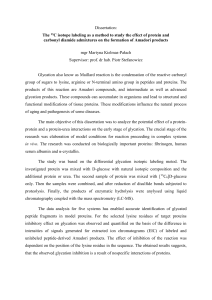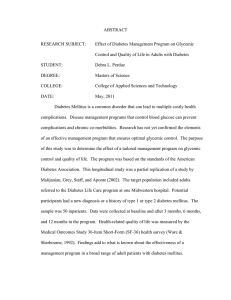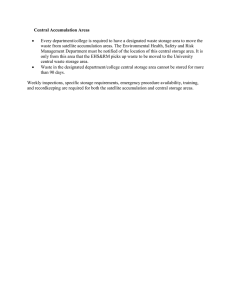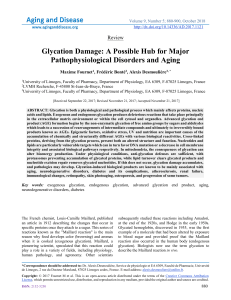Advance Journal of Food Science and Technology 8(10): 725-729, 2015
advertisement
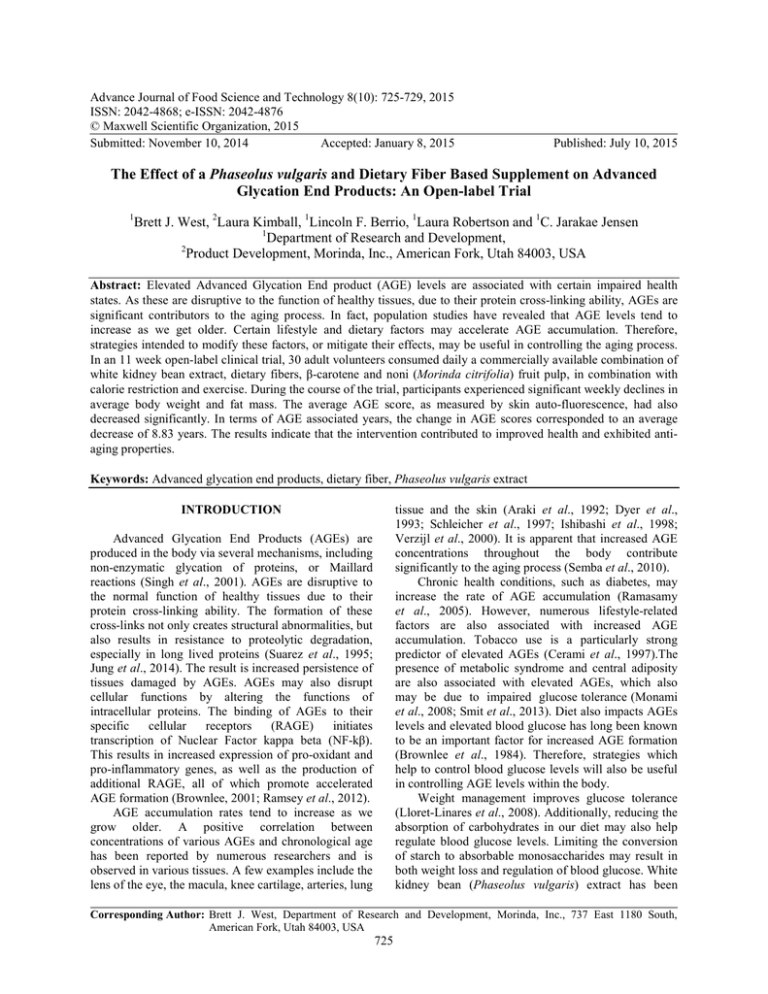
Advance Journal of Food Science and Technology 8(10): 725-729, 2015 ISSN: 2042-4868; e-ISSN: 2042-4876 © Maxwell Scientific Organization, 2015 Submitted: November 10, 2014 Accepted: January 8, 2015 Published: July 10, 2015 The Effect of a Phaseolus vulgaris and Dietary Fiber Based Supplement on Advanced Glycation End Products: An Open-label Trial 1 Brett J. West, 2Laura Kimball, 1Lincoln F. Berrio, 1Laura Robertson and 1C. Jarakae Jensen 1 Department of Research and Development, 2 Product Development, Morinda, Inc., American Fork, Utah 84003, USA Abstract: Elevated Advanced Glycation End product (AGE) levels are associated with certain impaired health states. As these are disruptive to the function of healthy tissues, due to their protein cross-linking ability, AGEs are significant contributors to the aging process. In fact, population studies have revealed that AGE levels tend to increase as we get older. Certain lifestyle and dietary factors may accelerate AGE accumulation. Therefore, strategies intended to modify these factors, or mitigate their effects, may be useful in controlling the aging process. In an 11 week open-label clinical trial, 30 adult volunteers consumed daily a commercially available combination of white kidney bean extract, dietary fibers, β-carotene and noni (Morinda citrifolia) fruit pulp, in combination with calorie restriction and exercise. During the course of the trial, participants experienced significant weekly declines in average body weight and fat mass. The average AGE score, as measured by skin auto-fluorescence, had also decreased significantly. In terms of AGE associated years, the change in AGE scores corresponded to an average decrease of 8.83 years. The results indicate that the intervention contributed to improved health and exhibited antiaging properties. Keywords: Advanced glycation end products, dietary fiber, Phaseolus vulgaris extract tissue and the skin (Araki et al., 1992; Dyer et al., 1993; Schleicher et al., 1997; Ishibashi et al., 1998; Verzijl et al., 2000). It is apparent that increased AGE concentrations throughout the body contribute significantly to the aging process (Semba et al., 2010). Chronic health conditions, such as diabetes, may increase the rate of AGE accumulation (Ramasamy et al., 2005). However, numerous lifestyle-related factors are also associated with increased AGE accumulation. Tobacco use is a particularly strong predictor of elevated AGEs (Cerami et al., 1997).The presence of metabolic syndrome and central adiposity are also associated with elevated AGEs, which also may be due to impaired glucose tolerance (Monami et al., 2008; Smit et al., 2013). Diet also impacts AGEs levels and elevated blood glucose has long been known to be an important factor for increased AGE formation (Brownlee et al., 1984). Therefore, strategies which help to control blood glucose levels will also be useful in controlling AGE levels within the body. Weight management improves glucose tolerance (Lloret-Linares et al., 2008). Additionally, reducing the absorption of carbohydrates in our diet may also help regulate blood glucose levels. Limiting the conversion of starch to absorbable monosaccharides may result in both weight loss and regulation of blood glucose. White kidney bean (Phaseolus vulgaris) extract has been INTRODUCTION Advanced Glycation End Products (AGEs) are produced in the body via several mechanisms, including non-enzymatic glycation of proteins, or Maillard reactions (Singh et al., 2001). AGEs are disruptive to the normal function of healthy tissues due to their protein cross-linking ability. The formation of these cross-links not only creates structural abnormalities, but also results in resistance to proteolytic degradation, especially in long lived proteins (Suarez et al., 1995; Jung et al., 2014). The result is increased persistence of tissues damaged by AGEs. AGEs may also disrupt cellular functions by altering the functions of intracellular proteins. The binding of AGEs to their specific cellular receptors (RAGE) initiates transcription of Nuclear Factor kappa beta (NF-kβ). This results in increased expression of pro-oxidant and pro-inflammatory genes, as well as the production of additional RAGE, all of which promote accelerated AGE formation (Brownlee, 2001; Ramsey et al., 2012). AGE accumulation rates tend to increase as we grow older. A positive correlation between concentrations of various AGEs and chronological age has been reported by numerous researchers and is observed in various tissues. A few examples include the lens of the eye, the macula, knee cartilage, arteries, lung Corresponding Author: Brett J. West, Department of Research and Development, Morinda, Inc., 737 East 1180 South, American Fork, Utah 84003, USA 725 Adv. J. Food Sci. Technol., 8(10): 725-729, 2015 demonstrated in human trials to help reduce body mass in overweight and obese adults and improve postprandial glycemic control (Udani and Singh, 2007; Barrett and Udani, 2011). The extract is able to produce these effects through inhibiting α-amylase, an enzyme which breaks down starch into absorbable monosaccharides (Marshall and Lauda, 1975). Dietary fiber intake also is reported to have positive effects on body weight, metabolic syndrome and blood glucose (Papathanasopoulos and Camilleri, 2009). Additionally, white kidney bean extract, β-carotene and noni fruit (Morinda citrifolia) have been found to possess antiglycation activity (Aruna et al., 1999; Pari and Venkateswaran, 2003; Kusirisin et al., 2009; Gacche and Dhole, 2011). Considering the background data, the current study was designed and conducted to investigate the efficacy of daily ingestion of a combination of white kidney bean extract, dietary fiber, β-carotene and noni fruit pulp in reducing AGE levels and body mass. Ramsey et al., 2012). Fat mass changes were also compared statistically with Student’s t-test. Advanced glycation end product measurements were made with the TruAge scanner, a consumer version of the AGE Reader mu (Diagnoptics Technologies B.V., Groningen, Netherlands). The scanner uses the principle of skin auto-fluorescence to measure AGE levels and is based on clinically validated methods (Meerwaldt et al., 2004). Each participant was instructed to not apply any lotions or skin treatments to the volar side of the forearm for at least one day prior to measurements with the scanner. Initial (day 0) and final (day 77) AGE measurements were made on a site of the volar forearm that was approximately 10 cm from the fold of the elbow. The TruAge scanner provides an AGE score, which is based on the intensity of skin auto-fluorescence through the 420-600 nm range, following excitation through the 300-420 nm range. Skin auto-fluorescence has been correlated with chronological age in multiple population studies (Koetsier et al., 2010; Yue et al., 2011; Simon Klenovics et al., 2013). Using a linear equation derived from the regression analyses in the studies, the AGE score can be used to calculate an age in years that corresponds to the intensity of skin auto-fluorescence. This is defined as the TruAge. Differences were calculated between each person’s actual age in years and the calculated TruAge (defined as TruAge difference). A positive TruAge difference value indicates that an individual has higher AGE levels than expected for their chronological age, based on the trends observed in population studies. A negative TruAge difference indicates that a person has lower AGE levels than expected for his or her chronological age. Significant changes in AGE scores and TruAge difference values were evaluated with Student’s t-test. MATERIALS AND METHODS Thirty adult volunteers were enrolled in this trial. Participants included males (n = 9) and females (n = 21) who ranged in age from 28-69 years. Those included had a Body Mass Index (BMI) of at least 24. Study participants were instructed to consume one daily serving of a commercially available combination of white kidney bean extract, dietary fiber, β-carotene and noni fruit pulp (TruAge Sugar Stop, Morinda, Inc., Provo, Utah, USA) immediately prior to consuming their largest meal of the day. This regimen was followed for 77 days (11 weeks). Participants were asked to record their food intake and track daily caloric intake using a website service or mobile device app, such as My Fitness Pal (MyFitnessPal Inc., San Francisco, California, USA) and Lose It! (FitNow, Inc., Boston, Massachusetts, USA). Using these services, each participant was instructed to adjust their daily calorie intake to achieve weekly weight loss goals that did not exceed 0.9 kg/week. They were also asked to exercise at least three times per week, with the specific type and duration left to the discretion of the individual. Informed consent was obtained from each participant. Body mass was measured at the initiation of the study (day 0) and then weekly, thereafter. Weekly weight changes from baseline values were calculated and the average weekly weight change per person, as well as standard deviation, were determined for each week. Average weight was compared against day 0 using Student’s t-test. Fat mass was also measured by a validated bioelectrical impedance method with the SC331S Body Composition Analyzer (Tanita Corporation of America, Inc., Arlington Heights, Illinois, USA) at the same time as body mass was measured, as described in previously reported studies (Ritchie et al., 2005; RESULTS AND DISCUSSION The average weekly change in weight, as compared to baseline values, is described in Fig. 1. There were consistent changes in weight throughout the 11 week period. The average weekly weight loss was 1.3 kg, which was 0.4 kg (or~0.9 Pounds) more than the 0.9 kg target of the daily calorie intake restriction. Mean weights were significantly different from the baseline mean at each subsequent week (p<0.0001). Fat mass also was reduced significantly. Mean fat mass, ±S.D., declined from 19.11±3.38 kg on day 0 to 17.51±3.41 kg by day 77 (p<0.00001). Changes in AGE measurements are described in Table 1. Mean AGE score declined by 10.6% from the initial value on day 0. Even so, AGE levels tend to increase with chronological age. As such, TruAge difference is a more accurate measurement for comparison since it controls for the effects of chronological age. The average TruAge difference on 726 Adv. J. Food Sci. Technol., 8(10): 725-729, 2015 carotene, a natural nutrient found in plant foods, has well known antioxidant properties (Bendich, 2004). Noni fruit juice also possesses significant antioxidant activity (Wang et al., 2009, 2013), although a minor component of the combination product. Reduction in sugar absorption by the white kidney bean extract is also an important consideration in the reduction in AGE levels. As stated above, supplementation with this extract in human trials reduced the body mass of overweight and obese adults and improved post-prandial glycemic control. Glycemic control is a key factor in controlling AGE accumulation, as blood sugar concentration is a limiting step in this process (Forbes and Cooper, 2013). As discussed previously, ingestion of dietary fiber appears to decrease postprandial glucose levels (Babio et al., 2010). Therefore, it contributes to the observed results by also improving glycemic control. Further, exercise is very effective in controlling blood glucose and ≥30 min/day for at least 3 day/week has been associated with lower skin auto-fluorescence levels (Simon Klenovics et al., 2013). Even when adequate glycemic control has been reached, the demonstrated antiglycation activity of β-carotene, noni fruit and white kidney bean extract should also help curb AGE accumulation. Fig. 1: Average weekly weight reduction from baseline, ± standard deviation Table 1: Initial, day 0 and final, day 77, mean AGE score and TruAge difference, ±standard deviation Measurement Day 0 Day 77 AGE score 199.16±26.02 77.96±22.34* TruAge difference (years) 2.33±8.61 -6.50±7.22* Change in TruAge difference -8.83±4.55 (years) *: p<0.0001 day 0 was 2.33 years. This indicates that this group of participants had elevated AGE levels when compared against healthy population trends. Afterwards, all participants experienced a decline in TruAge difference. The minimum decline was 2 years, with the maximum being 20. By day 77, all participants had AGE levels that either matched expected values for their age or had levels that were expected for people younger than themselves. After 11 weeks, mean TruAge difference declined significantly to -6.5 years, which indicates that this group had much lower AGE levels than expected among the healthy general population. In terms of AGE associated years, this is an average decline of 8.83 years. The results of this pilot study are consistent with data presented in previous reports. As discussed above, lifestyle factors and health status influence AGE accumulation. In type 2 diabetics, skin autofluorescence not only increases with hyperglycemia and age but also with the presence of abdominal obesity (Monami et al., 2008; Den Engelsen et al., 2012). Not only is obesity a predictor, but increased BMI is also a determinant of skin auto-fluorescence (Lutgers et al., 2006). Therefore, it is very reasonable that positive changes to body composition are likely to result in similar changes to AGE levels. One reason for this is that oxidative stress is enhanced by central obesity (Urakawa et al., 2003; Furukawa et al., 2004; Silver et al., 2007). As oxidative stress is also a promoter of AGE formation (Araki, 1997; Miyata et al., 1997), reduction in fat mass should contribute to a reduced pro-oxidant environment within the body. Within the context of oxidative stress, it is important to note that β- CONCLUSION The results of this open-label clinical trial indicate that the daily use of a combination of white kidney bean extract, dietary fiber and noni fruit pulp, along with calorie restriction and exercise, improves the AGE load in the body, reduces body weight and improves lean body composition. The presumed decrease in sugar intake, as well as improved glycemic control, contributes to the lower rate of AGE accumulation, resulting in improved overall health and a reduction in AGE associated years. As such, the intervention evaluated in this study may be useful as an anti-aging strategy. REFERENCES Araki, A., 1997. Oxidative stress and diabetes mellitus: a possible role of alpha-dicarbonyl compounds in free radical formation. Nihon Ronen Igakkai Zasshi, 34: 716-720. Araki, N., N. Ueno, B. Chakrabarti, Y. Morino and S. Horiuchi, 1992. Immunochemical evidence for the presence of advanced glycation end products in human lens proteins and its positive correlation with aging. J. Biol. Chem., 267: 10211-10214. Aruna, R.V., B. Ramesh and V.N. Kartha, 1999. Effect of betacarotene on protein glycosylation in alloxan induced diabetic rats. Indian J. Exp. Biol., 37: 399-401. 727 Adv. J. Food Sci. Technol., 8(10): 725-729, 2015 Koetsier, M., H.L. Lutgers, C. de Jonge, T.P. Links, A.J. Smit and R. Graaff, 2010. Reference values of skin autofluorescence. Diabetes Technol. The., 12: 399-403. Kusirisin, W., S. Srichairatanakool, P. Lerttrakarnnon, N. Lailerd, M. Suttajit, C. Jaikang and C. Chaiyasut, 2009. Antioxidative activity, polyphenolic content and anti-glycation effect of some Thai medicinal plants traditionally used in diabetic patients. Med. Chem., 5: 139-147. Lloret-Linares, C., J.R. Greenfield and S. Czernichow, 2008. Effect of weight-reducing agents on glycaemic parameters and progression to Type 2 diabetes: A review. Diabetic Med., 25: 1142-1150. Lutgers, H.L., R. Graaff, T.P. Links, L.J. UbinkVeltmaat, H.J. Bilo, R.O. Gans and A.J. Smit, 2006. Skin autofluorescence as a noninvasive marker of vascular damage in patients with type 2 diabetes. Diabetes Care, 29: 2654-2659. Marshall, J.J. and C.M. Lauda, 1975. Purification and properties of phaseolamin, an inhibitor of alphaamylase, from the kidney bean, Phaseolus vulgaris. J. Biol. Chem., 250: 8030-8037. Meerwaldt, R., R. Graaff, P.H. Oomen, T.P. Links, J.J. Jager, N.L. Alderson, S.R. Thorpe, J.W. Baynes, R.O. Gans and A.J. Smit, 2004. Simple non-invasive assessment of advanced glycation endproduct accumulation. Diabetologia, 47: 1324-1330. Miyata, T., Y. Wada, Z. Cai, Y. Iida, K. Horie, Y. Yasuda, K. Maeda, K. Kurokawa and C. van Ypersele de Strihou, 1997. Implication of an increased oxidative stress in the formation of advanced glycation end products in patients with end-stage renal failure. Kidney Int., 51: 1170-1181. Monami, M., C. Lamanna, F. Gori, F. Bartalucci, N. Marchionni and E. Mannucci, 2008. Skin autofluorescence in type 2 diabetes: Beyond blood glucose. Diabetes Res. Clin. Pr., 79: 56-60. Papathanasopoulos, A. and M. Camilleri, 2009. Dietary fiber supplements: effects in obesity and metabolic syndrome and relationship to gastrointestinal functions. Gastroenterology, 138: 65-72. Pari, L. and S. Venkateswaran, 2003. Effect of an aqueous extract of Phaseolus vulgaris on the properties of tail tendon collagen of rats with streptozotocin-induced diabetes. Braz. J. Med. Biol. Res., 36: 861-70. Ramasamy, R., S.J. Vannucci, S.S. Yan, K. Herold, S.F. Yan and A.M. Schmidt, 2005. Advanced glycation end products and RAGE: A common thread in aging, diabetes, neurodegeneration and inflammation. Glycobiology, 15: 16R-28R. Ramsey, R., E. Isenring and L. Daniels, 2012. Comparing measures of fat-free mass in overweight older adults using three different bioelectrical impedance devices and three prediction equations. J. Nutr. Health Aging, 16: 26-30. Babio, N., R. Balanza, J. Basulto, M. Bulló and J. Salas-Salvadó, 2010. Dietary fibre: Influence on body weight, glycemic control and plasma cholesterol profile. Nutr. Hosp., 25: 327-340. Barrett, M.L. and J.K. Udani, 2011. A proprietary alpha-amylase inhibitor from white bean (Phaseolus vulgaris): A review of clinical studies on weight loss and glycemic control. Nutr. J., 10: 24. Bendich, A., 2004. From 1989 to 2001: What have we learned about the "biological actions of betacarotene"? J. Nutr., 134: 225S-230S. Brownlee, M., 2001. Biochemistry and molecular cell biology of diabetic complications. Nature, 414: 813-820. Brownlee, M., H. Vlassara and A. Cerami, 1984. Nonenzymatic glycosylation and the pathogenesis of diabetic complications. Ann. Intern. Med., 101: 527-537. Cerami, C., H. Founds, I. Nicholl, T. Mitsuhashi, D. Giordano, S. Vanpatten, A. Lee, Y. Al-Abed, H. Vlassara, R. Bucala and A. Cerami, 1997. Tobacco smoke is a source of toxic reactive glycation products. P. Natl. Acad. Sci. USA, 94: 13915-13920. Den Engelsen, C., M. van den Donk, K.J. Gorter, P.L. Salomé and G.E. Rutten, 2012. Advanced glycation end products measured by skin autofluorescence in a population with central obesity. Dermatoendocrinology, 4: 33-38. Dyer, D.G., J.A. Dunn, S.R. Thorpe, K.E. Bailie, T.J. Lyons, D.R. McCance and J.W. Baynes, 1993. Accumulation of Maillard reaction products in skin collagen in diabetes and aging. J. Clin. Invest., 91: 2463-2469. Forbes, J.M. and M.E. Cooper, 2013. Mechanisms of diabetic complications. Physiol. Rev., 93: 137-188. Furukawa, S., T. Fujita, M. Shimabukuro, M. Iwaki, Y. Yamada, Y. Nakajima, O. Nakayama, M. Makishima, M. Matsuda and I. Shimomura, 2004. Increased oxidative stress in obesity and its impact on metabolic syndrome. J. Clin. Invest., 114: 1752-1761. Gacche, R.N. and N.A. Dhole, 2011. Profile of aldose reductase inhibition, anti-cataract and free radical scavenging activity of selected medicinal plants: an attempt to standardize the botanicals for amelioration of diabetes complications. Food Chem. Toxicol., 49: 1806-1813. Ishibashi, T., T. Murata, M. Hangai, R. Nagai, S. Horiuchi, P.F., Lopez, D.R. Hinton and S.J. Ryan, 1998. Advanced glycation end products in age-related macular degeneration. Arch. Ophthalmol., 116: 1629-1632. Jung, T., A. Hohn and T. Grune, 2014. The proteasome and the degradation of oxidized proteins: Part IIprotein oxidation and proteasomal degradation. Redox Biol., 2: 99-104. 728 Adv. J. Food Sci. Technol., 8(10): 725-729, 2015 Suarez, G., J.D. Etlinger, J. Maturana and D. Weitman, 1995. Fructated protein is more resistant to ATPdependent proteolysis than glucated protein possibly as a result of higher content of Maillard fluorophores. Arch. Biochem. Biophys., 321: 209-213. Udani, J. and B.B. Singh, 2007. Blocking carbohydrate absorption and weight loss: A clinical trial using a proprietary fractionated white bean extract. Altern. Ther. Health M., 13: 32-37. Urakawa, H., A. Katsuki, Y. Sumida, E.C. Gabazza, S. Murashima, K. Morioka, N. Maruyama, N. Kitagawa, T. Tanaka, Y. Hori, K. Nakatani, Y. Yano and Y. Adachi, 2003. Oxidative stress is associated with adiposity and insulin resistance in men. J. Clin. Endocr. Metab., 88: 4673-4676. Verzijl, N., J. DeGroot, S.R. Thorpe, R.A. Bank, J.N. Shaw, T.J. Lyons, J.W. Bijlsma, F.P. Lafeber, J.W. Baynes and J.M. TeKoppele, 2000. Effect of collagen turnover on the accumulation of advanced glycation end products. J. Biol. Chem., 275: 39027-39031. Wang, M.Y., L. Peng, C.J. Jensen, S. Deng and B.J. West, 2013. Noni juice reduces lipid peroxidation-derived DNA adducts in heavy smokers. Food Sci. Nutr., 1: 141-149. Wang, M.Y., M.N. Lutfiyya, V. Weidenbacher-Hoper, G. Anderson, C.X. Su and B.J. West, 2009. Antioxidant activity of noni juice in heavy smokers. Chem. Cent. J., 3(13): 1-5. Yue, X., H. Hu, M. Koetsier, R. Graaff and C. Han, 2011. Reference values for the Chinese population of skin autofluorescence as a marker of advanced glycation end products accumulated in tissue. Diabetic Med., 28: 818-823. Ritchie, J.D., C.K. Miller and H. Smiciklas-Wright, 2005. Tanita foot-to-foot bioelectrical impedance analysis system validated in older adults. J. Am. Diet. Assoc., 105: 1617-1619. Schleicher, E.D., E. Wagner and A.G. Nerlich, 1997. Increased accumulation of the glycoxidation product N(epsilon)-(carboxymethyl) lysine in human tissues in diabetes and aging. J. Clin. Invest., 99: 457-468. Semba, R.D., E.J. Nicklett and L. Ferrucci, 2010. Does accumulation of advanced glycation end products contribute to the aging phenotype? J. Gerontol. ABiol., 65: 963-975. Silver, A.E., S.D. Beske, D.D. Christou, A.J. Donato, K.L. Moreau, I. Eskurza, P.E. Gates and D.R. Seals, 2007. Overweight and obese humans demonstrate increased vascular endothelial NAD(P)H oxidase-p47phox expression and evidence of endothelial oxidative stress. Circulation, 115: 627-637. Simon Klenovics, K., R. Kollárová, J. Hodosy, P. Celec and K. Sebeková, 2013. Reference values of skin autofluorescence as an estimation of tissue accumulation of advanced glycation end products in a general Slovak population. Diabetic Med., 31: 581-585. Singh, R., A. Bardenm, T. Mori and L. Beilin, 2001. Advanced glycation end-products: A review. Diabetologia, 44: 129-146. Smit, A.J., J.M. Smit, G.J. Botterblom and D.J. Mulder, 2013. Skin autofluorescence based decision tree in detection of impaired glucose tolerance and diabetes. PLoS One, 8: e65592. 729
